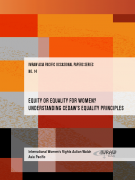IWRAW: Equity or Equality for Women? Understanding CEDAW's Equality Principles
| Attachment | Size |
|---|---|
| OPS14_Web.pdf | 653.21 KB |

This essay argues that CEDAW’s concept of equality is what is needed to end discrimination against women. It first traces the background of the controversy over the use of the terms equity and equality in international human rights law. Finally, to further demonstrate the importance of CEDAW’s principles of equality, and particularly that of substantive equality, it provides some illustrations of the positive impact these principles have had on domestic gender jurisprudence.
It then describes the CEDAW Committee’s recent attempts to emphasize the distinction between “equality” and “equity” and its continuing efforts to clarify the meaning of CEDAW’s broad concept of gender equality. Next, it examines the three principles that make up CEDAW’s concept of equality: the principle of nondiscrimination, the principle of state obligation and the principle of substantive equality, or equality of results. Following this examination of the meaning of equality in CEDAW, it presents a human rights-based critique of attempts to use “equity” to replace equality. The examples here are drawn from Costa Rica, where decisions generally have been receptive to arguments for substantive equality. The essay closes with a brief look at the impact CEDAW’s principles of equality can have in a country such as the United States, which regrettably is one of the few countries that has not yet ratified CEDAW.
Full document attached.


